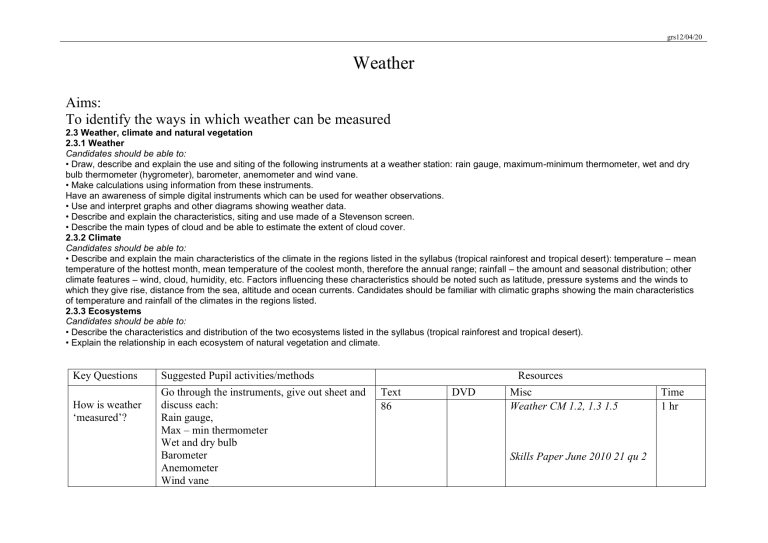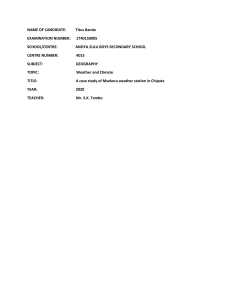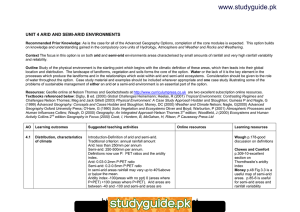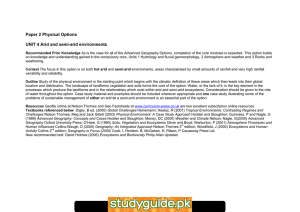Scheme of work - geographylwc.org.uk

grs12/04/20
Weather
Aims:
To identify the ways in which weather can be measured
2.3 Weather, climate and natural vegetation
2.3.1 Weather
Candidates should be able to:
• Draw, describe and explain the use and siting of the following instruments at a weather station: rain gauge, maximum-minimum thermometer, wet and dry bulb thermometer (hygrometer), barometer, anemometer and wind vane.
• Make calculations using information from these instruments.
Have an awareness of simple digital instruments which can be used for weather observations.
• Use and interpret graphs and other diagrams showing weather data.
• Describe and explain the characteristics, siting and use made of a Stevenson screen.
• Describe the main types of cloud and be able to estimate the extent of cloud cover.
2.3.2 Climate
Candidates should be able to:
• Describe and explain the main characteristics of the climate in the regions listed in the syllabus (tropical rainforest and tropical desert): temperature – mean temperature of the hottest month, mean temperature of the coolest month, therefore the annual range; rainfall – the amount and seasonal distribution; other climate features – wind, cloud, humidity, etc. Factors influencing these characteristics should be noted such as latitude, pressure systems and the winds to which they give rise, distance from the sea, altitude and ocean currents. Candidates should be familiar with climatic graphs showing the main characteristics of temperature and rainfall of the climates in the regions listed.
2.3.3 Ecosystems
Candidates should be able to:
• Describe the characteristics and distribution of the two ecosystems listed in the syllabus (tropical rainforest and tropical desert).
• Explain the relationship in each ecosystem of natural vegetation and climate.
Key Questions Suggested Pupil activities/methods Resources
How is weather
‘measured’?
Go through the instruments, give out sheet and discuss each:
Rain gauge,
Max – min thermometer
Wet and dry bulb
Barometer
Anemometer
Wind vane
Text
86
DVD Misc
Weather CM 1.2, 1.3 1.5
Skills Paper June 2010 21 qu 2
Time
1 hr
What is the
Stevenson
Screen?
Go through the shape, construction and location of the SS.
Use a photo
Discuss what instruments are found within the
SS
What are the main types of cloud and how is cloud cover measured?
ASSESSMENT
Use photos for cloud types
Produce own weather log for two weeks
What are the main characteristics of the TRF climate
What are the main characteristics of the Tropical desert climate
Include temperature, hottest, coldest, and range
Rainfall. Seasonal distribution
Also cloud, wind and humidity.
Locate on world map, with equator. Draw climate graph
Explain causes of climate, include latitude, pressure systems, winds, dist from sea, altitude and ocean current. Spider diagram here
Include temperature, hottest, coldest, and range
Rainfall. Seasonal distribution
Also cloud, wind and humidity.
Locate on world map, with equator and tropics.
Draw climate graph
Explain causes of climate, include latitude, pressure systems, winds, dist from sea, altitude and ocean current. Spider diagram here
88
92
Bunnet P 225
Waugh 202
Key 2 19
Key CM 2.2(Assessment?)
1 grs12/04/20
½
Fwk paper
Nov 08 qu 2
Waugh 196
Key 2 18
Key CM 2.1(Assessment?)
½
1
What are the characteristics and distribution of the TRF?
What issues are related to the
TRF?
Discuss adaptations to climate
Discuss deforestation, go through desertification
Complete the pie charts the causes of
What are the characteristics and distribution of the desert ecosystem?
ASSESSMENT
Discuss adaptations to climate, consider also desertification
94
94
Bunnett 246
Waugh 197
Key CM 4.1, assess 4.1
GeoActive 232
Key CM 5.1
Key CM 5.2
Key Assess 5.1
Geoact 241
New WW P 95
Waugh P 202
Key CM5.4
Key Assess 5.3
1 grs12/04/20
1











